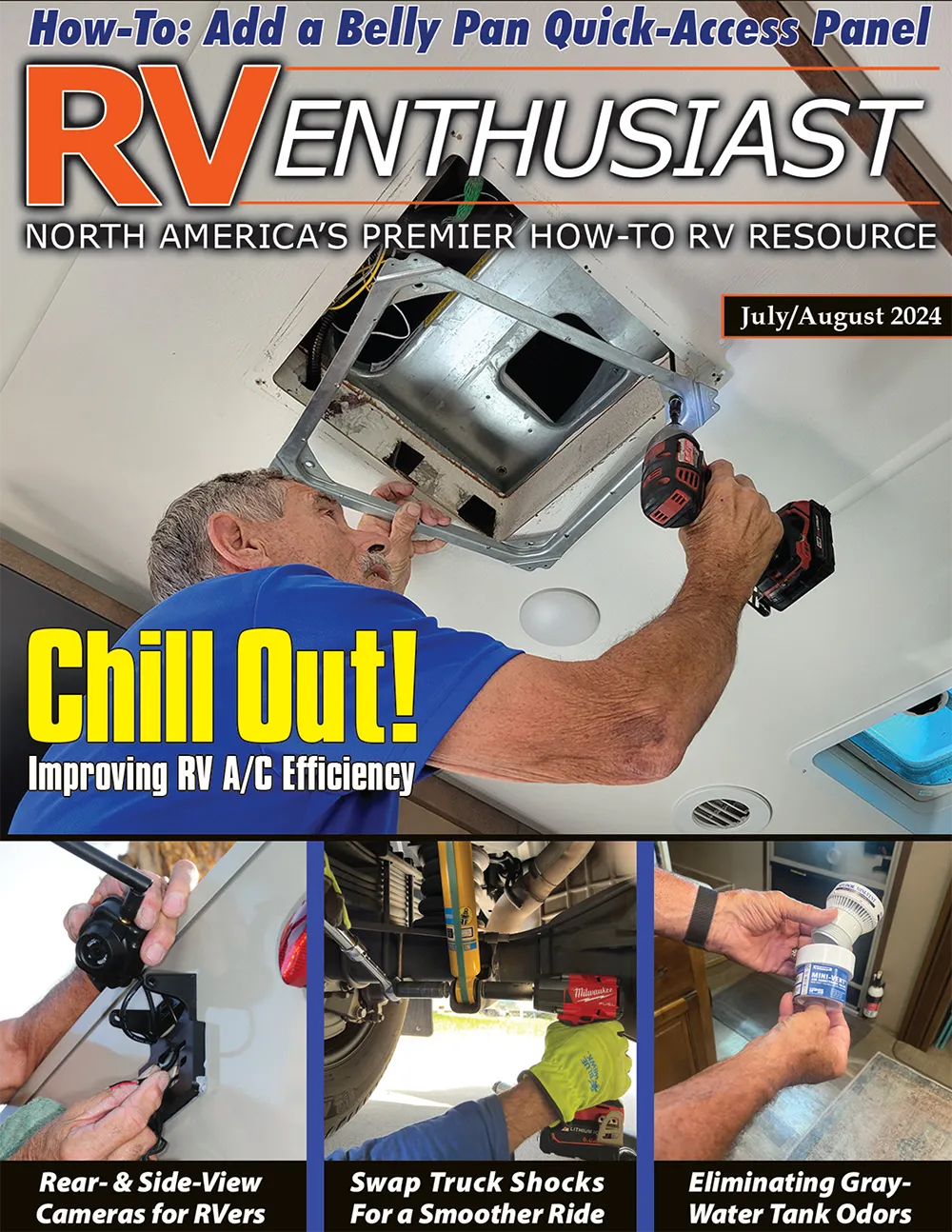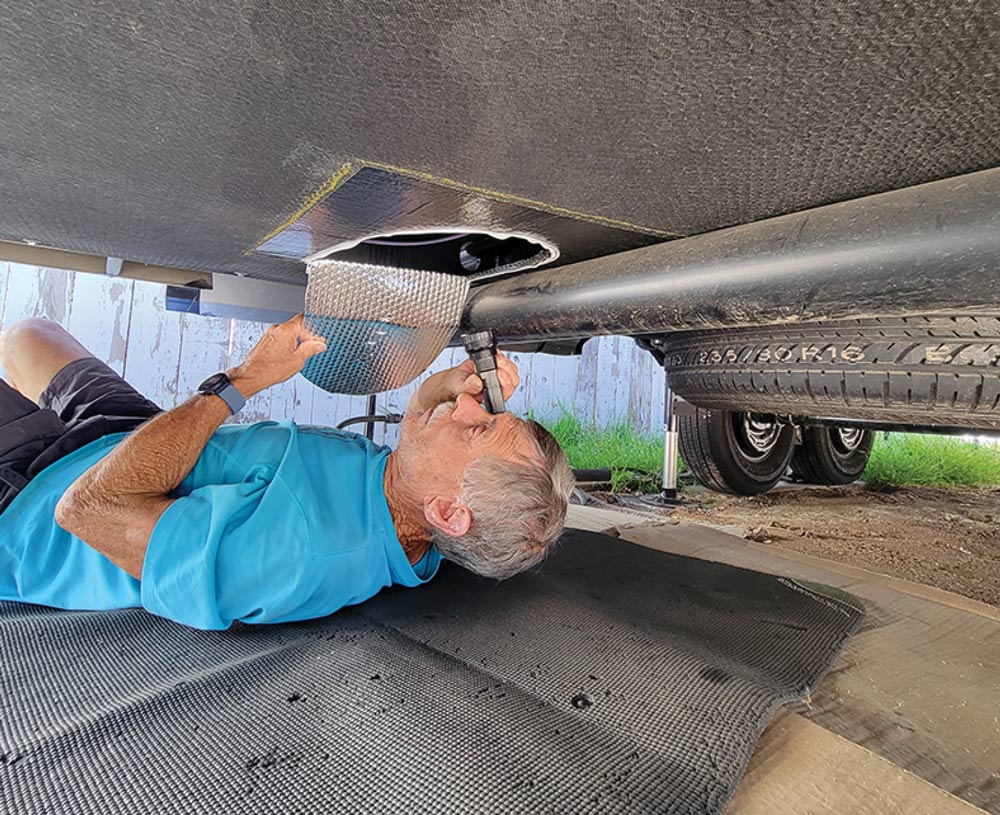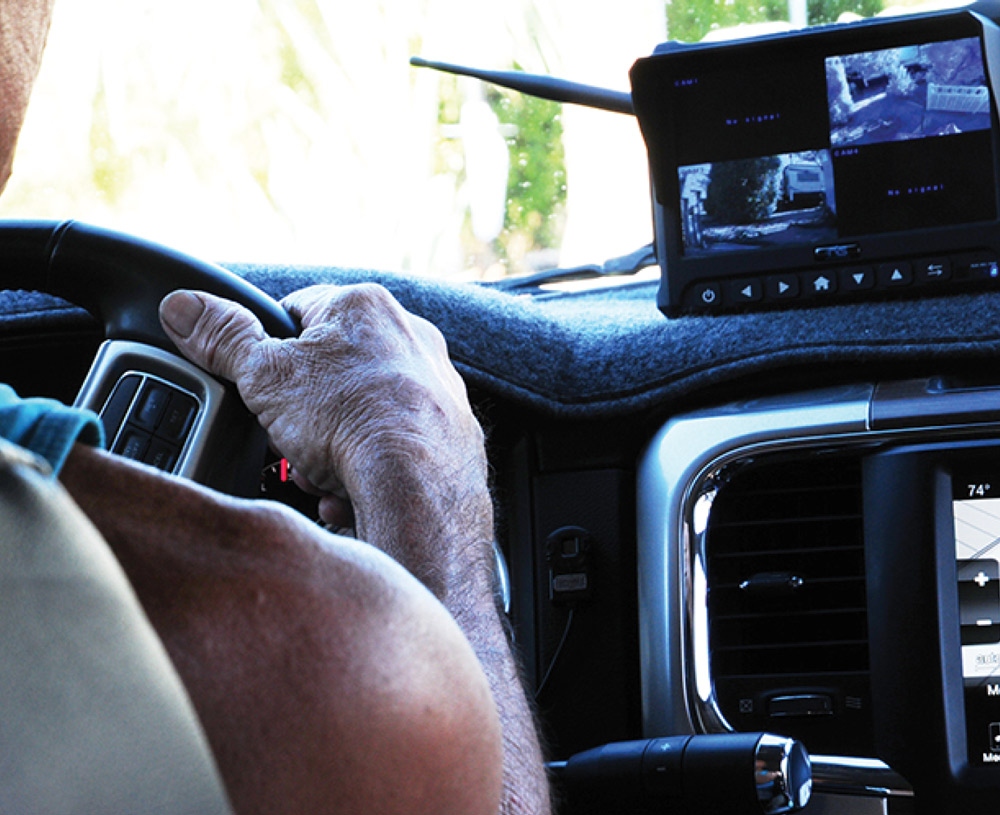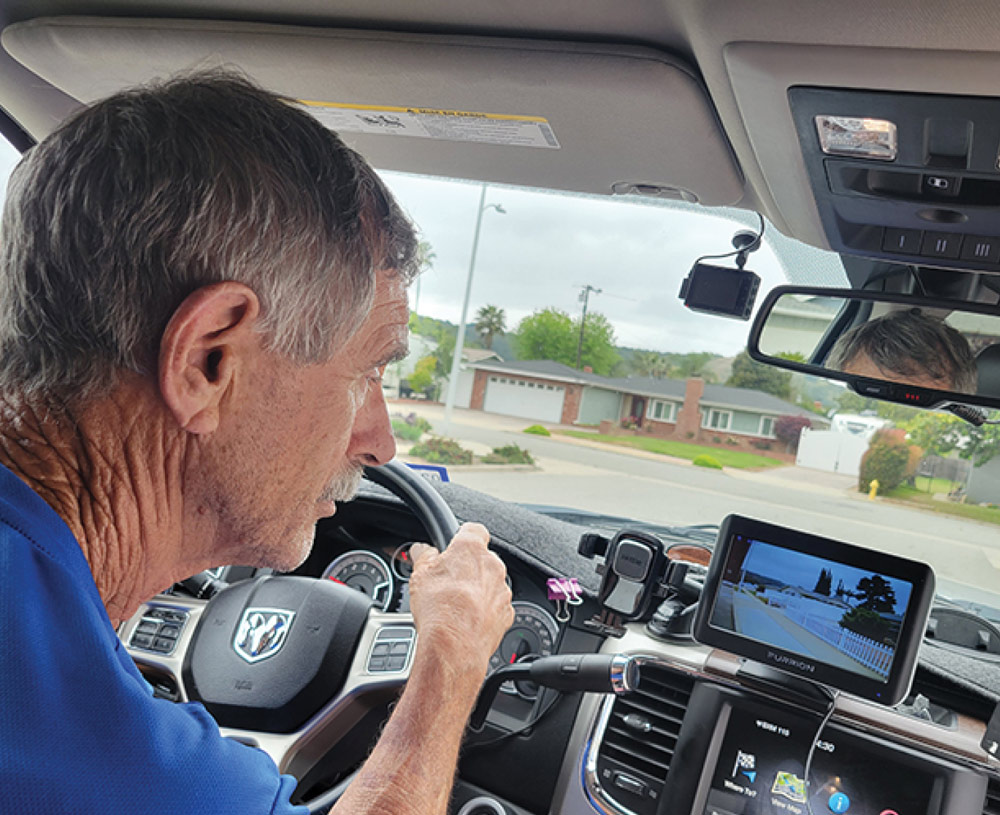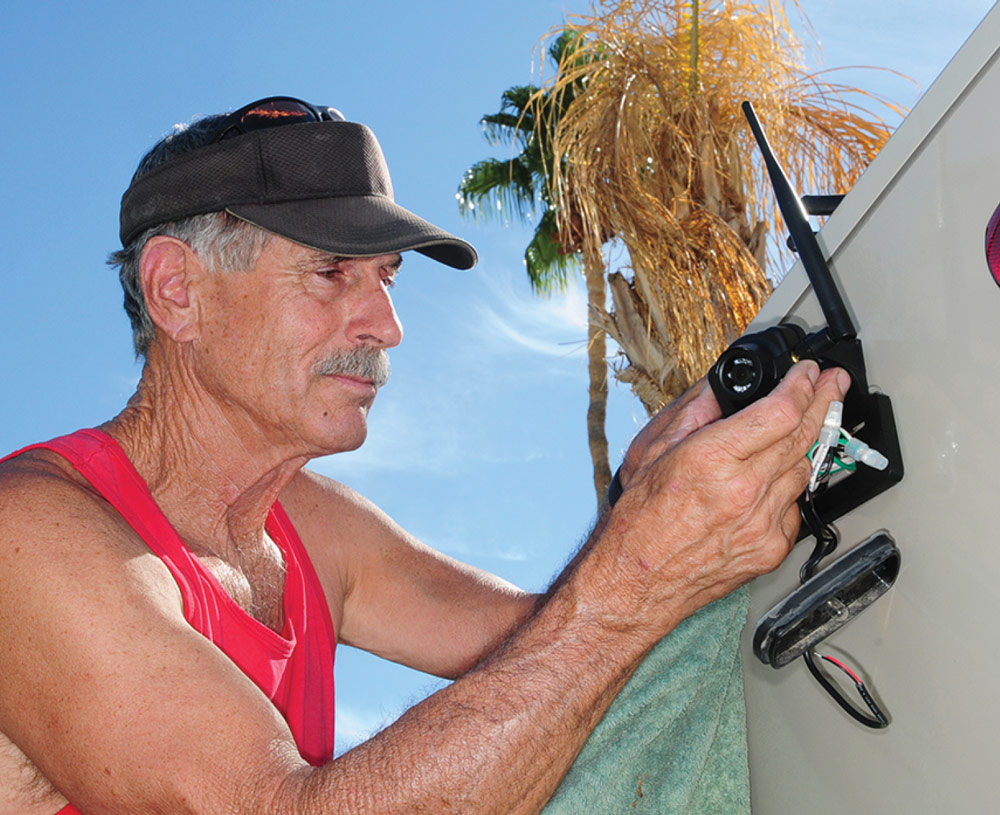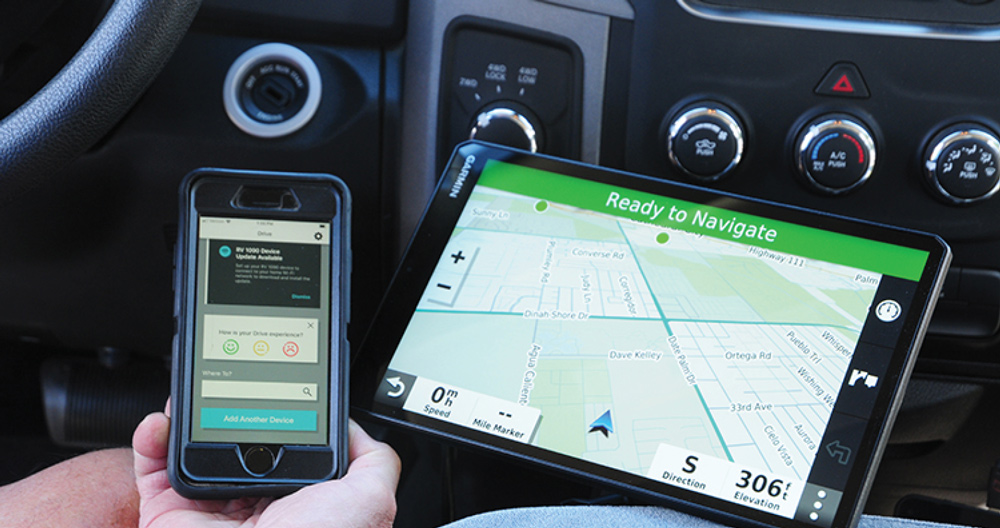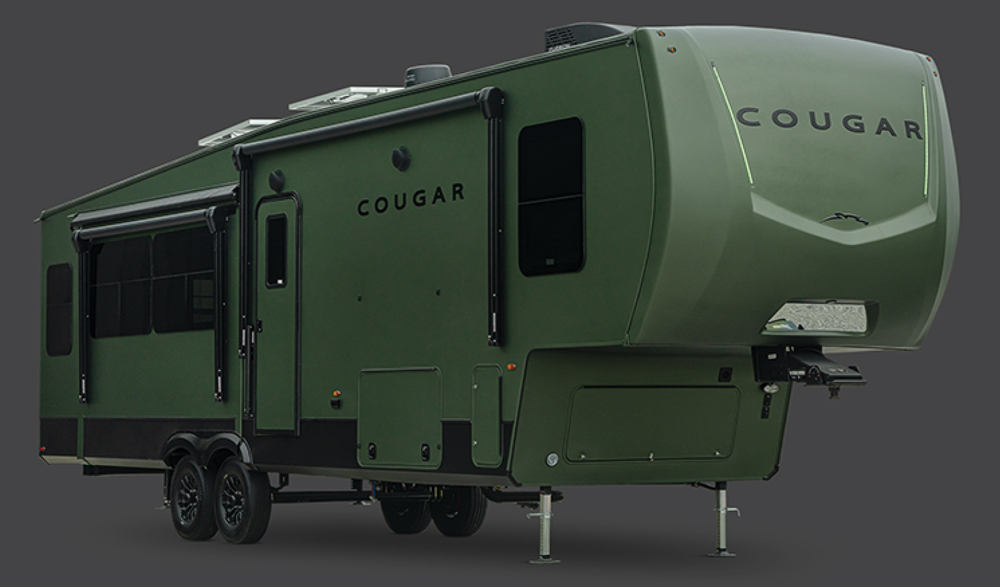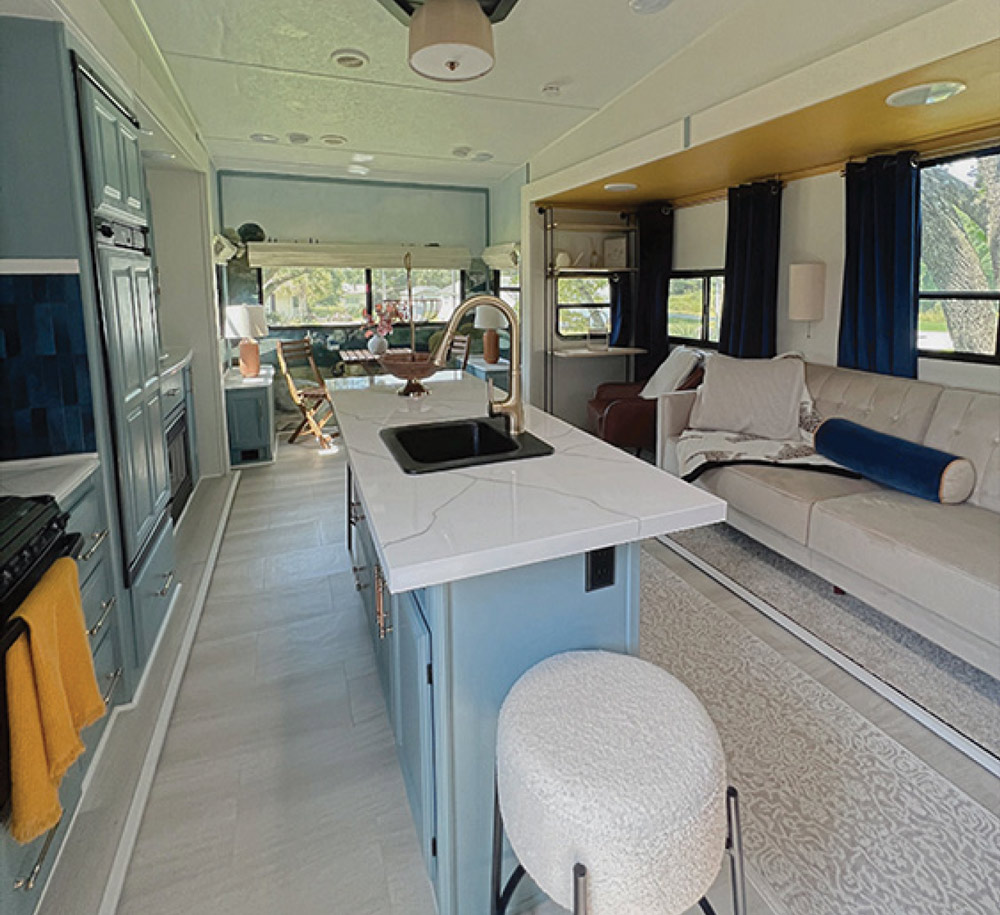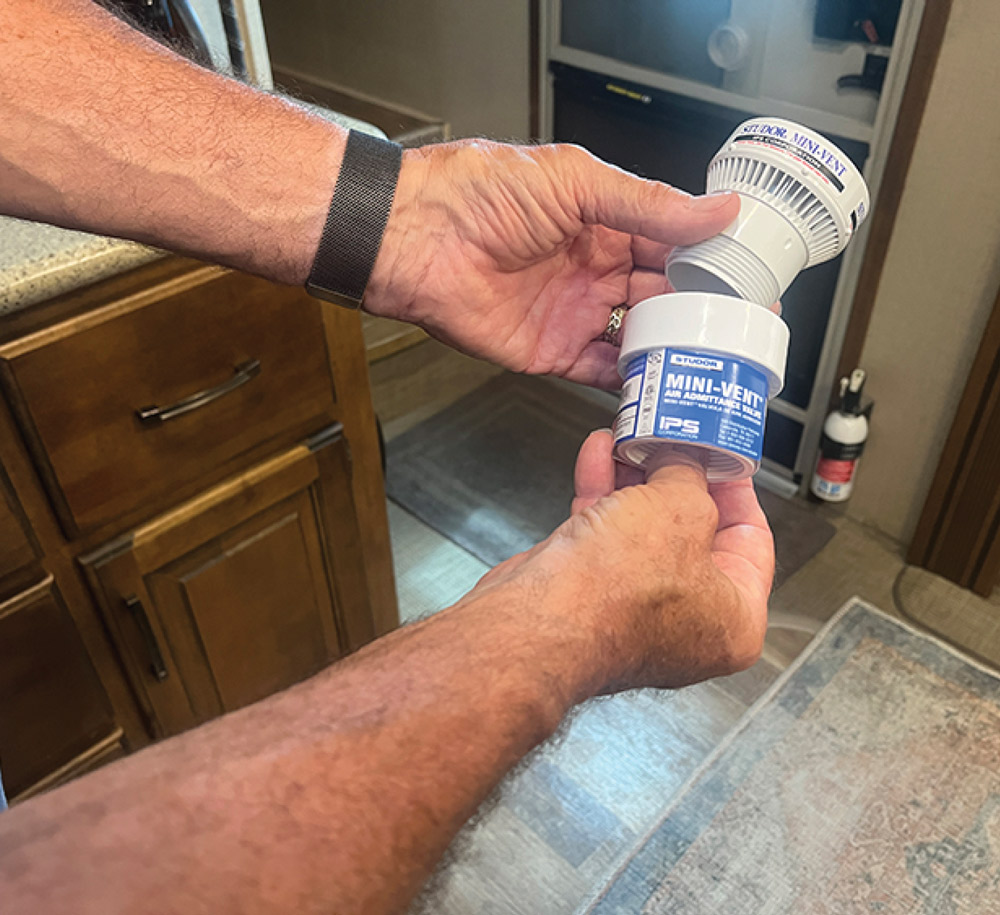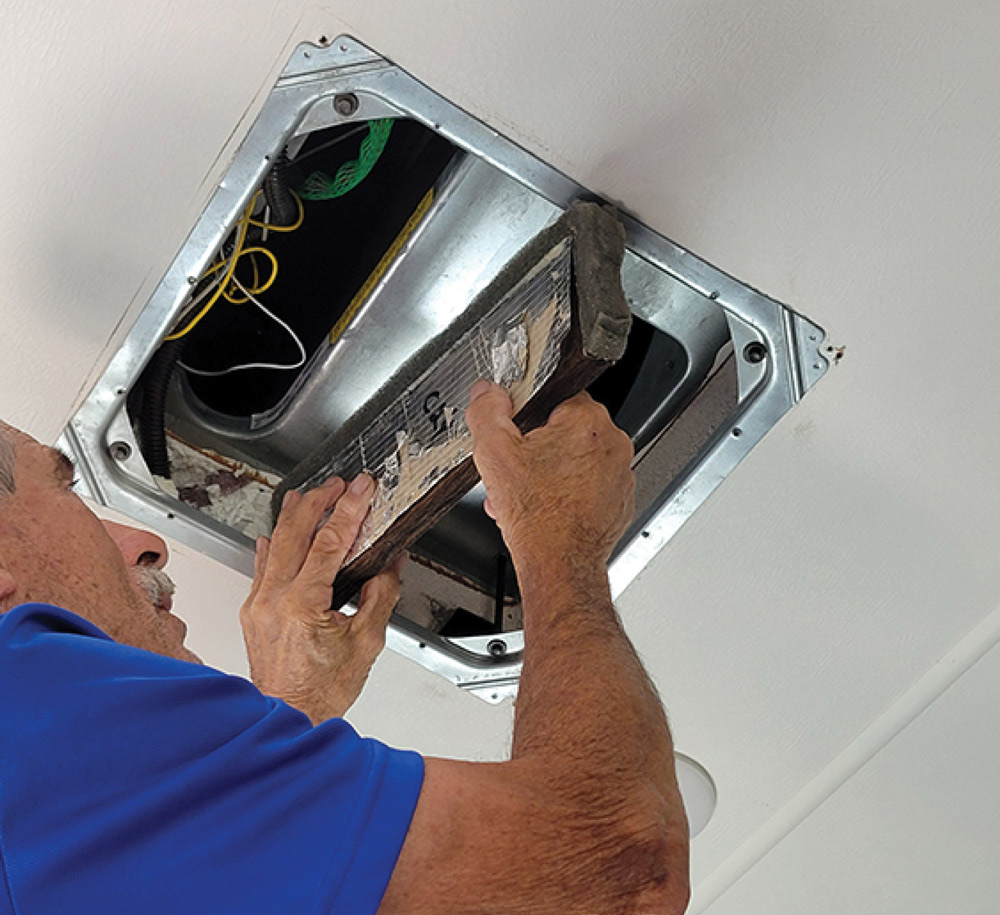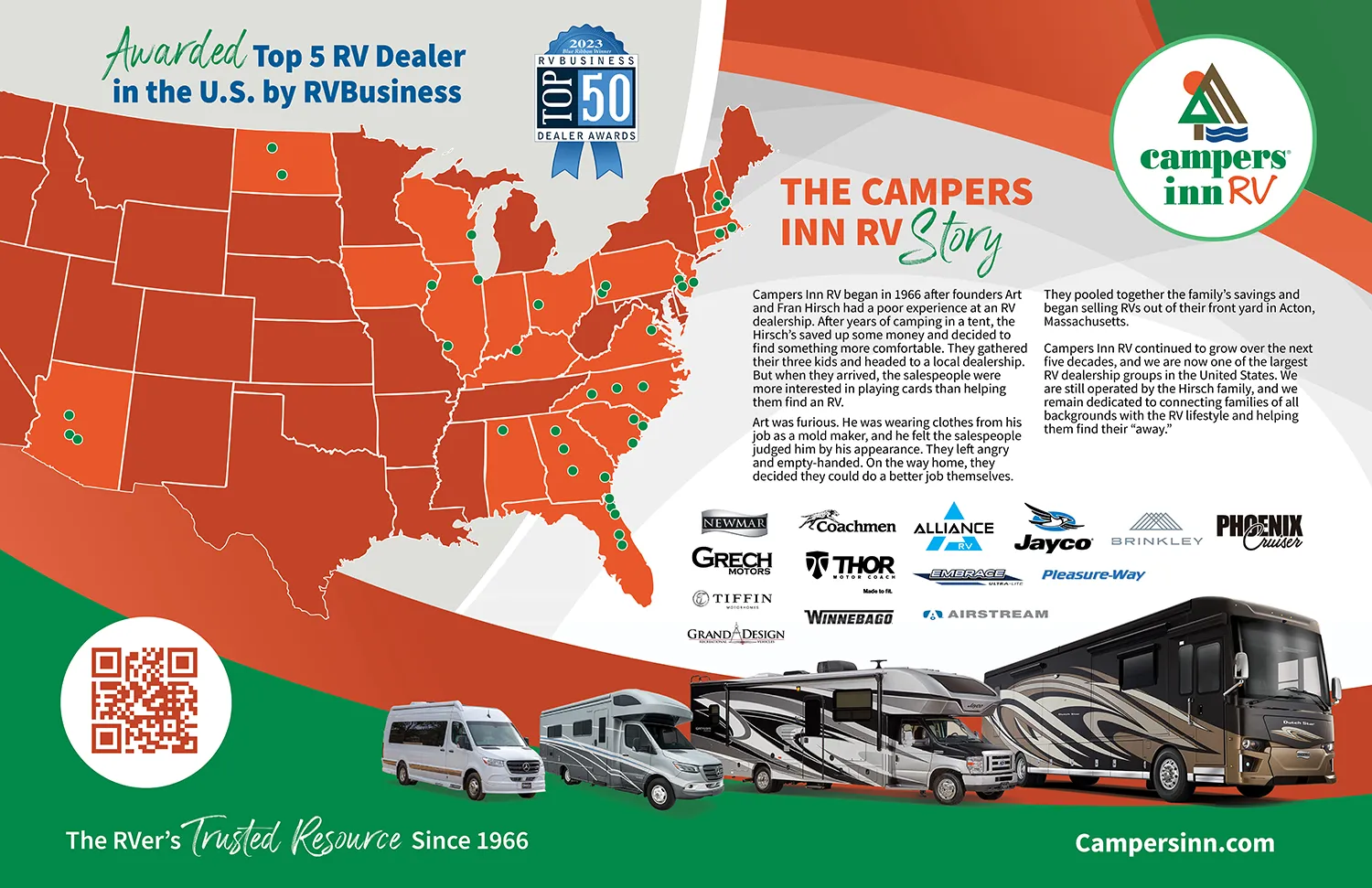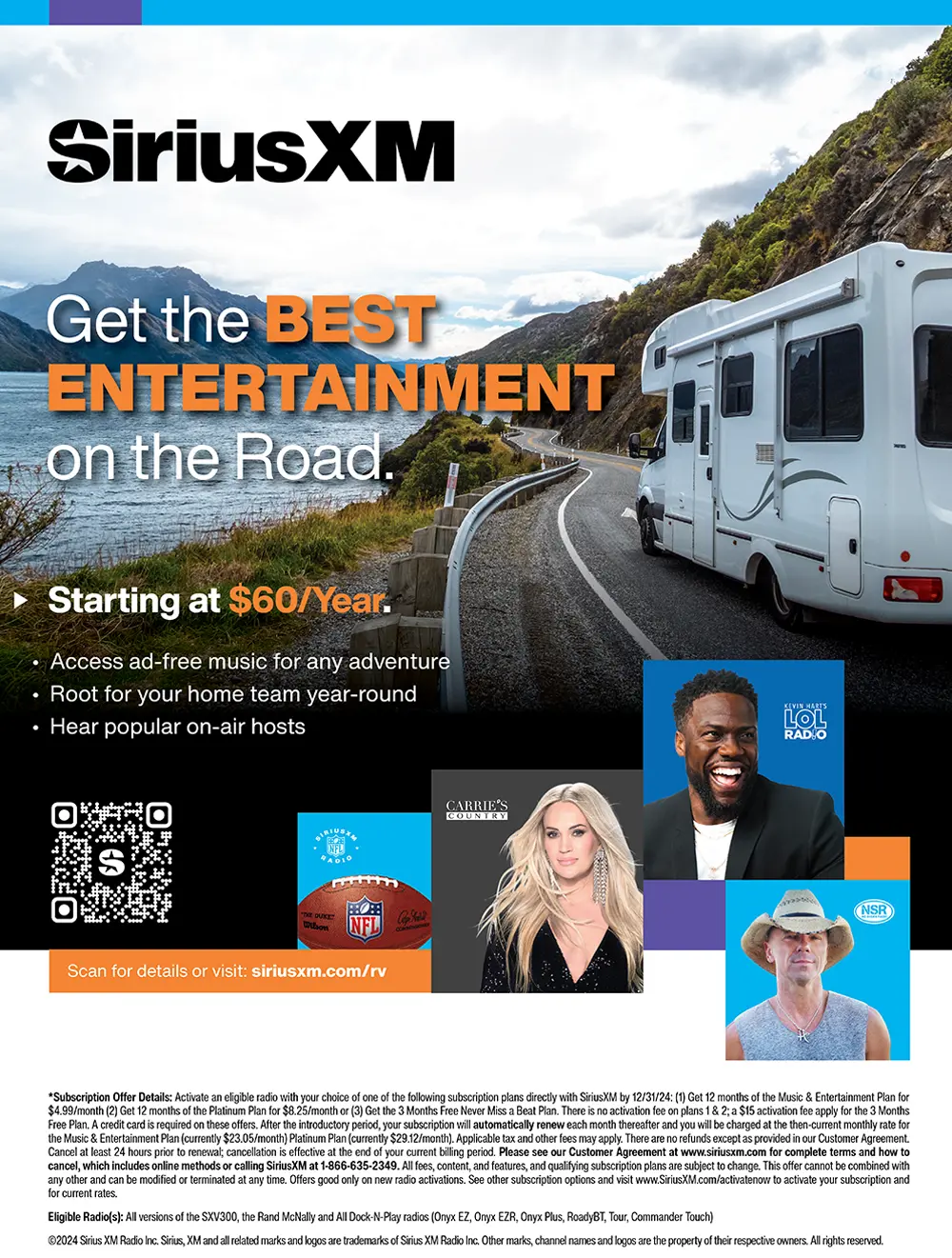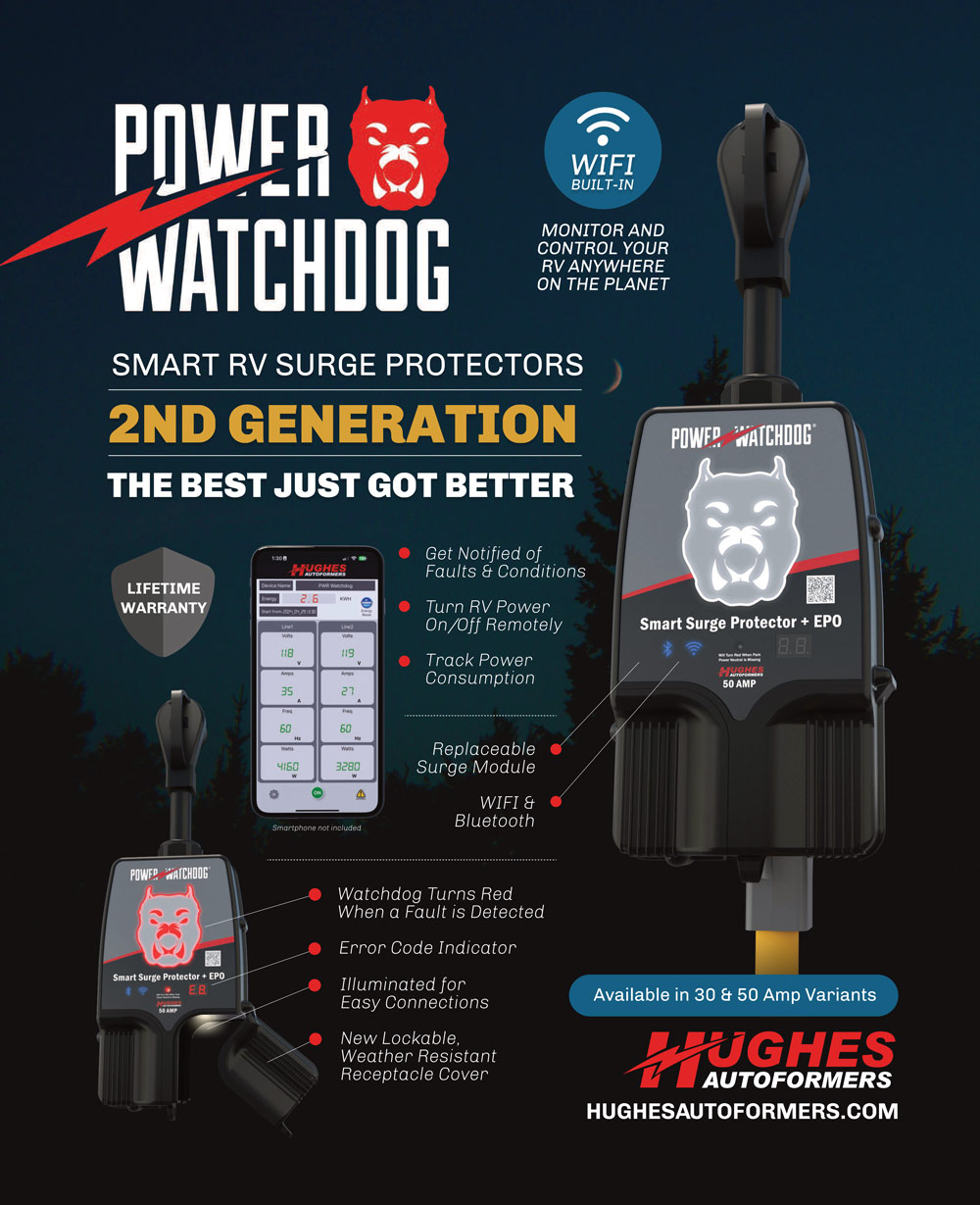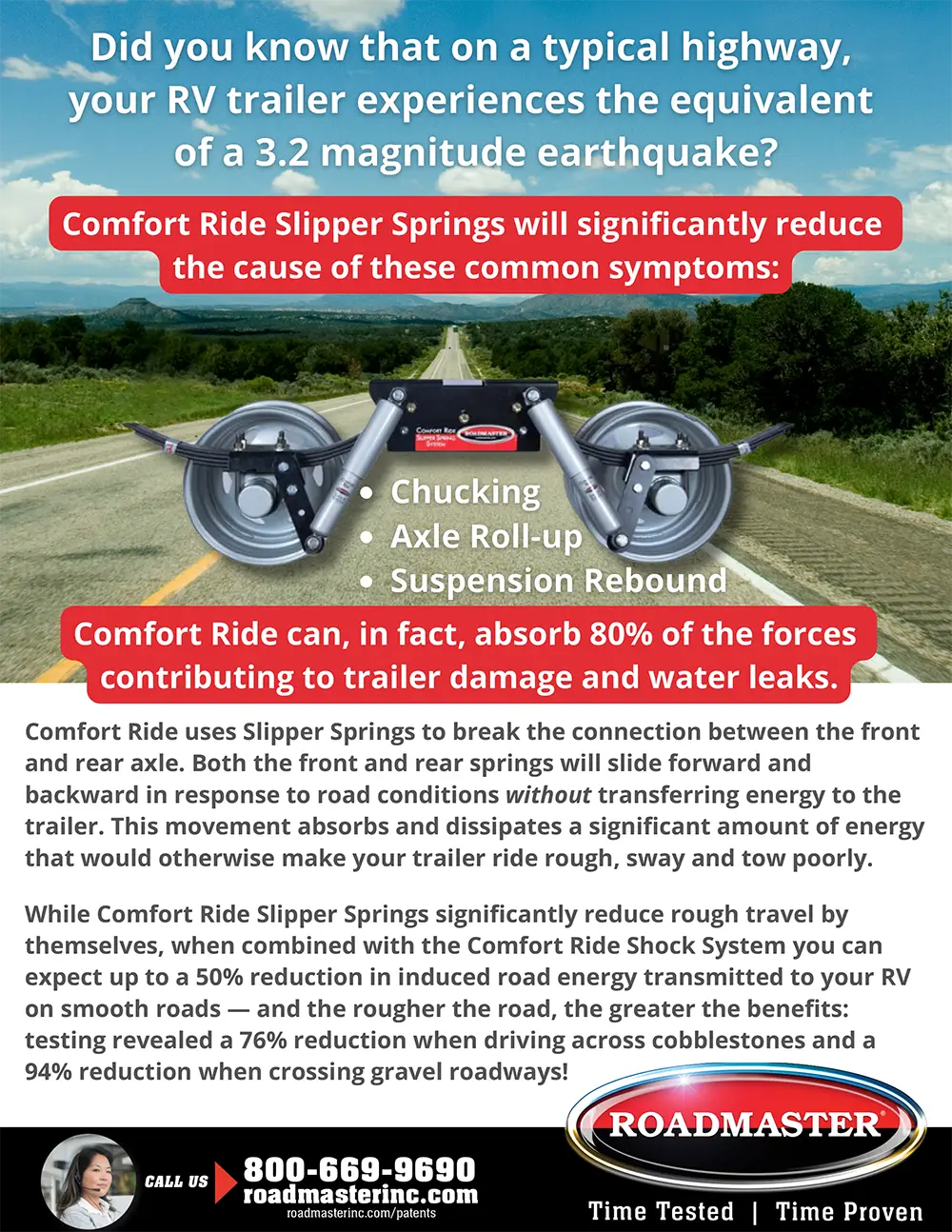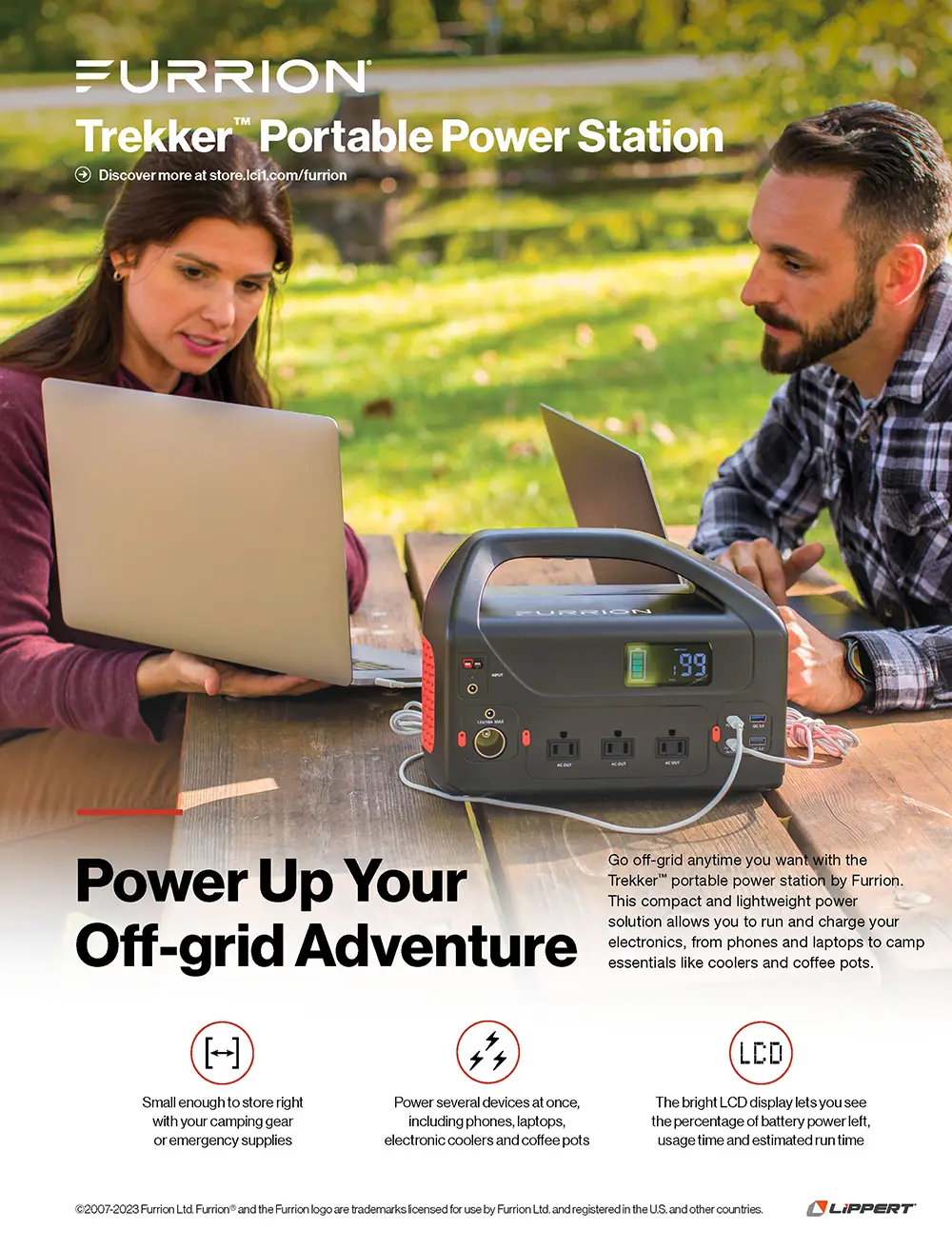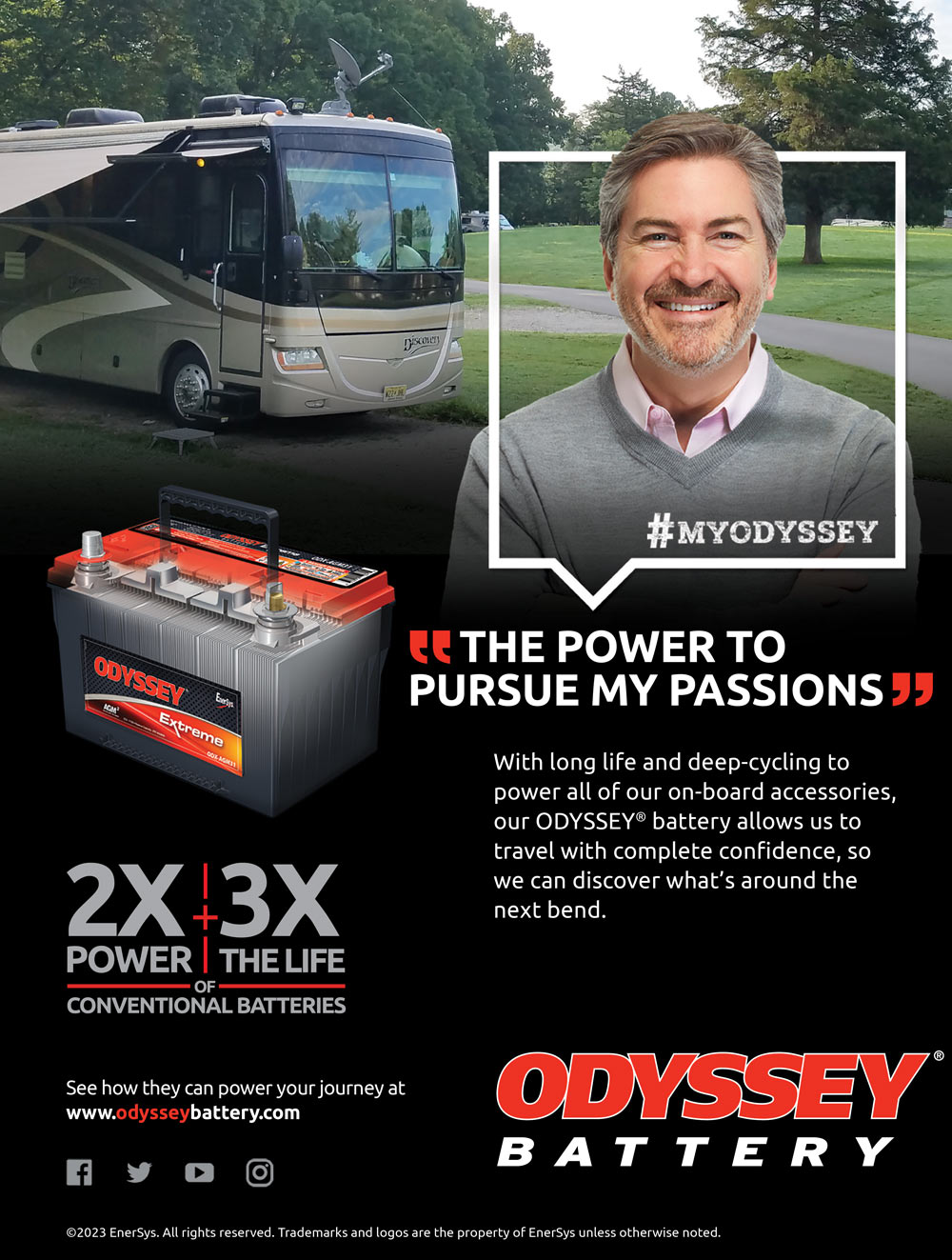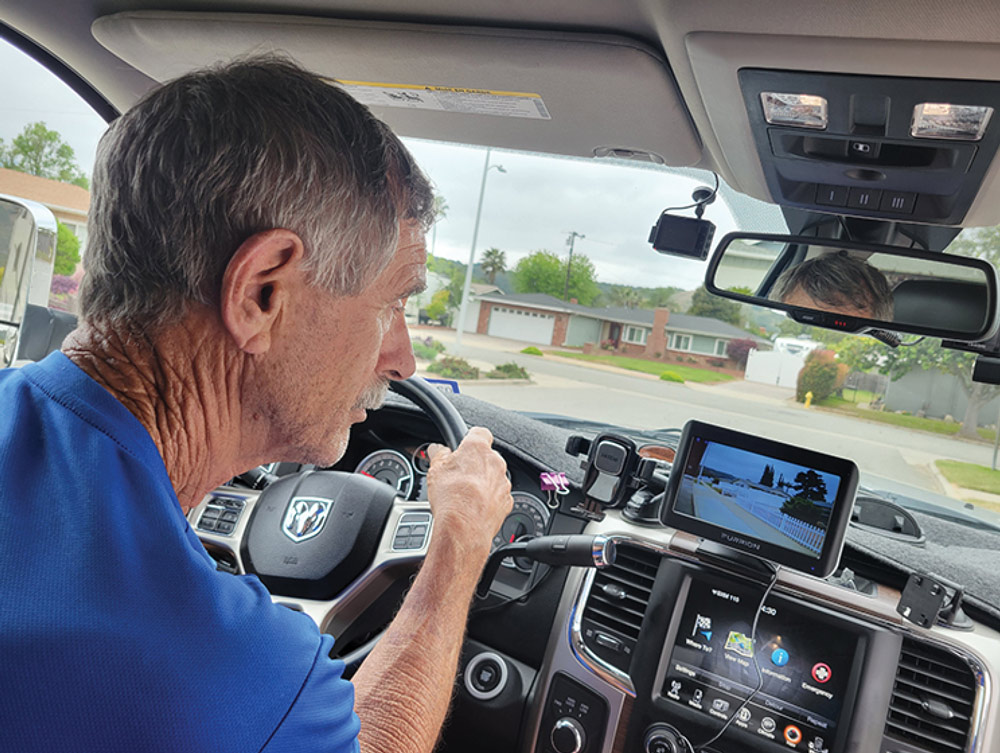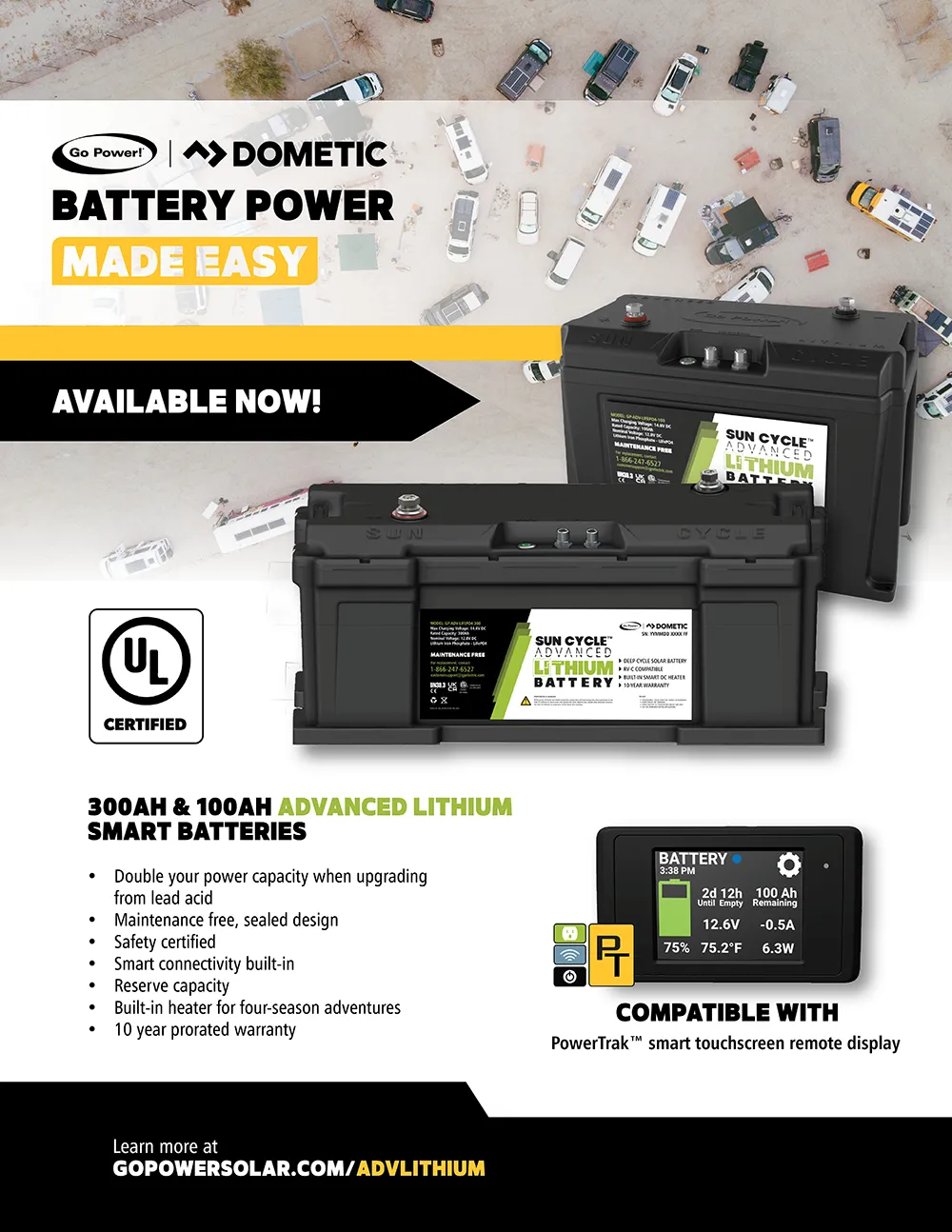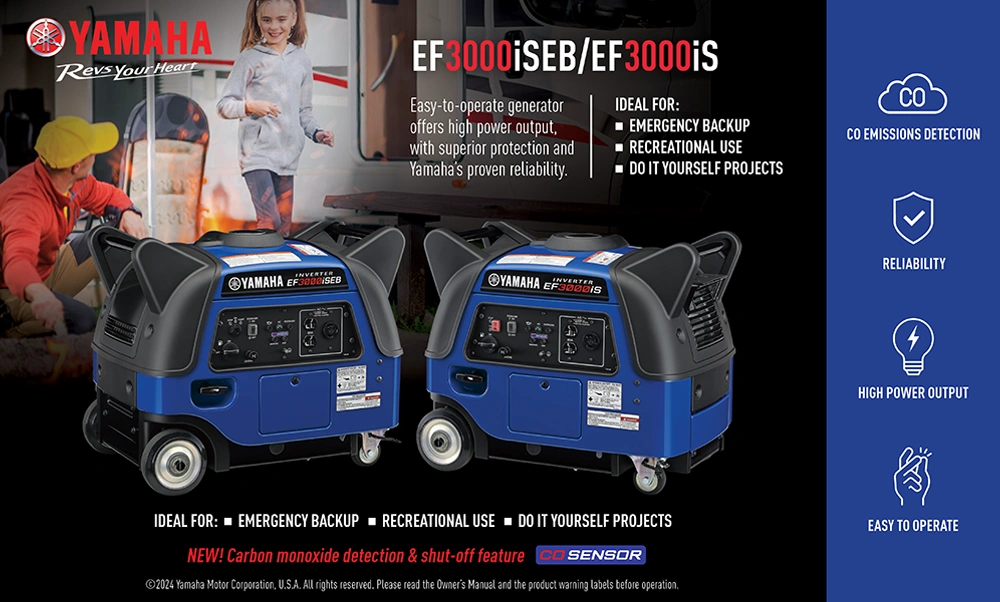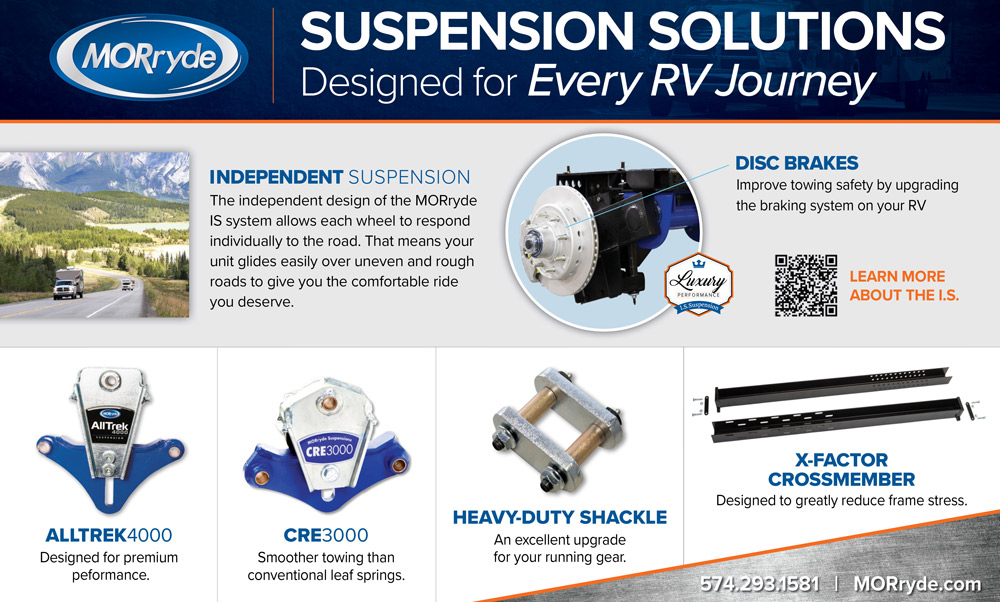Subscriber Access Only
Special Offer
Get 1 year of RV Enthusiast Magazine for just $9.99
Unlock My Offer No ThanksAlready a subscriber? Click here to access full issues.

Belly pans protect an RV’s underside from road debris and help keep things warm in colder weather, but they can make it difficult should repairs to plumbing or wiring be necessary. This two-part story shows how to create a zippered trap door for easy access — and how to repair the pan by “stitching” accidental cuts and tears.
Backing up an RV can send chills down anyone’s spine. Fortunately, the aftermarket has responded with a host of rear- and side-view cameras to help prevent on-road collisions and backing snafus — and keep the peace with traveling partners. Here’s a look at top wireless systems.
Backing up an RV — especially a big fifth wheel — helps if you have eyes all around the rig. Since most of us don’t travel with a support crew, installing a plug-and-play camera system with both rear- and side-mounted “eyes” — like this Furrion Vision S RV 3-Camera System — can really take the edge off the chore.
Not everyone wants or needs a rear-view camera with all the bells and whistles. One of the best basic systems available is the vueSMART from Hopkins Towing Solutions. It mounts in under an hour, has a wide 152-degree viewing area, includes six LED lights for illuminating dark spaces and transmits to your smart device.
Contemporary RVs are quite amazing, when you think about it — but they are still manufactured for mass appeal. Mostly, that means wood tones — lots and lots of wood tones. Of late, however, a cottage industry of RV renovators like Tessa Terry have begun changing the paradigm, injecting character and personality into these road homes.
Just about anyone who’s spent any time camping in an RV knows that smells can emanate from places other than the blackwater holding tank. Yup, graywater can stink, too — but when the air becomes tainted with noxious odors, the culprit is usually a bad air-admittance valve. Replacing it will keep your nose happy.
Staying cool inside an RV is a prerequisite in hot weather, but it’s sometimes easier said than done. The inherent design — and placement — of rooftop air-conditioners limits their effectiveness. You can “change the weather” somewhat inside by installing the A/C Connect from Kool RV.
Heavy-duty pickup trucks are a “must” for handling big trailers and campers — but that capability often comes with a rough ride. It’s no secret that factory shock absorbers provide only minimal damping of road conditions, but owners can improve drivability and ride quality by swapping out the stock shocks for Bilstein units.
(805) 320-6909
[email protected]
EDITOR – Bruce Hampson
(574) 584-4616
[email protected]
TECHNICAL DIRECTOR
BILL GEHR
(805) 340-5015
[email protected]
ART DIRECTOR – MIKE ACCUARDI
[email protected]
26362 Douglas ave., Elkhart, in 46514
 AFFILIATE NOTICE: RVE Media Group LLC provides links to vendors and products, such as an Amazon Associates account, for informational purposes, but that may provide a commission if you purchase from that link. We often label these links with language that provides transparency if the destination is an advertiser, affiliate, or partner. Products are often provided to RVE at little/no cost for editorial testing purposes by vendors/suppliers. Under no circumstances does this affect the results of the test or install as published in RV Enthusiast. Sponsored content is identified as such directly on the content.
AFFILIATE NOTICE: RVE Media Group LLC provides links to vendors and products, such as an Amazon Associates account, for informational purposes, but that may provide a commission if you purchase from that link. We often label these links with language that provides transparency if the destination is an advertiser, affiliate, or partner. Products are often provided to RVE at little/no cost for editorial testing purposes by vendors/suppliers. Under no circumstances does this affect the results of the test or install as published in RV Enthusiast. Sponsored content is identified as such directly on the content.
PRIVACY POLICY: Our complete privacy policy can be found at https://rventhusiast.com/privacy-policy/
he RV experience is on the cusp of a transformation unlike most of us have ever seen before. Traveling today is augmented by a plethora of technological tools as our copilot. No, I’m not trying to lessen the value of those sitting in the right-hand seat — that person’s role is more important than ever. The way it’s handled is just different today.
We’re all linked to our “smart” devices.
RV travel presents challenging moments simply because the vehicles are bigger than cars and require more space to maneuver and park. Years ago, RV-specific GPS devices took the sting out of finding our way; today, it’s hard to find a new tow vehicle or motorhome without a GPS. Navigation, though, is just a tiny part of the travel experience. Valuable information — to include destinations, RV park reservations, travel weather, fuel stops and technical help — is now instantly at RV owners’ fingertips.
A bugaboo for most RVers is finding adequate fueling stops without getting into a bind because of the island/pump configuration and/or the number of parked cars that restrict the turning area. Truck stops are great for those who use diesel, but the lines can be long on popular Interstate routes. Recently, while on a cross-country trip caravanning with friends in another fifth wheel, we turned into a station that looked bigger than it really was and created an instant traffic jam — embarrassingly, with no way to turn without causing a stir. It wasn’t a pretty scene while the other customers snarled at us to get out of the way. A new app, Trucker Path, one of many to find adequate fueling resources recommended by friends, solved that problem.
Sponsored Content
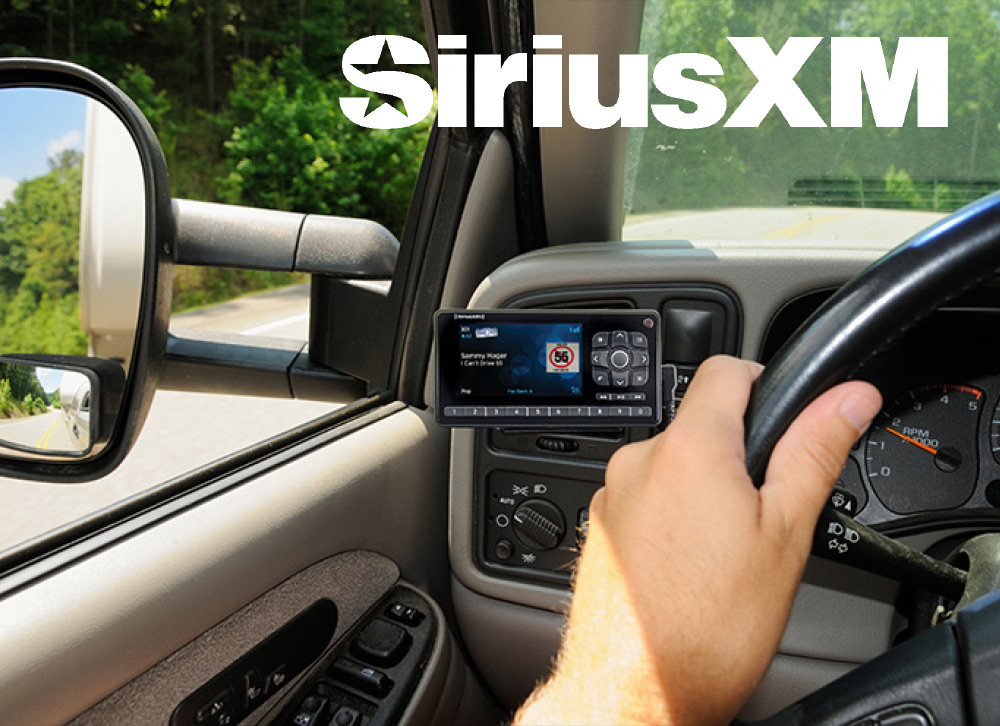
So why not enjoy every part of your journey with SiriusXM satellite radio?
For 15+ years and counting, SiriusXM has been serving up the best in-vehicle entertainment featuring popular on-air personalities like Howard Stern alongside your favorite bands, artists and music genres. Whether you’re traveling near or far, SiriusXM can provide coast-to-coast coverage both in and out of your motorized RV or towable vehicle.
Currently, we offer 425+ channels of ad-free music, plus sports, news, talk and comedy — including 165+ channels in the car. With a wide variety of music — ranging from timeless classics by Billy Joel, Jimmy Buffet and more to the latest and greatest from pop stars like Kelly Clarkson and Taylor Swift — you can listen to all the artists you love in one place. Plus, SiriusXM talk stations and podcasts cover topics like fashion, finance, faith, politics, health and overall lifestyles. Hear from hosts like John Mayer, James Cordon, Tinx, Kevin Hart and others, along with A-list interviews you’ll never forget. Sports fans can get live comprehensive coverage of the NFL, NASCAR, MLB, NBA, and other prominent leagues and events so you can root for any home team year-round.
News & Notes
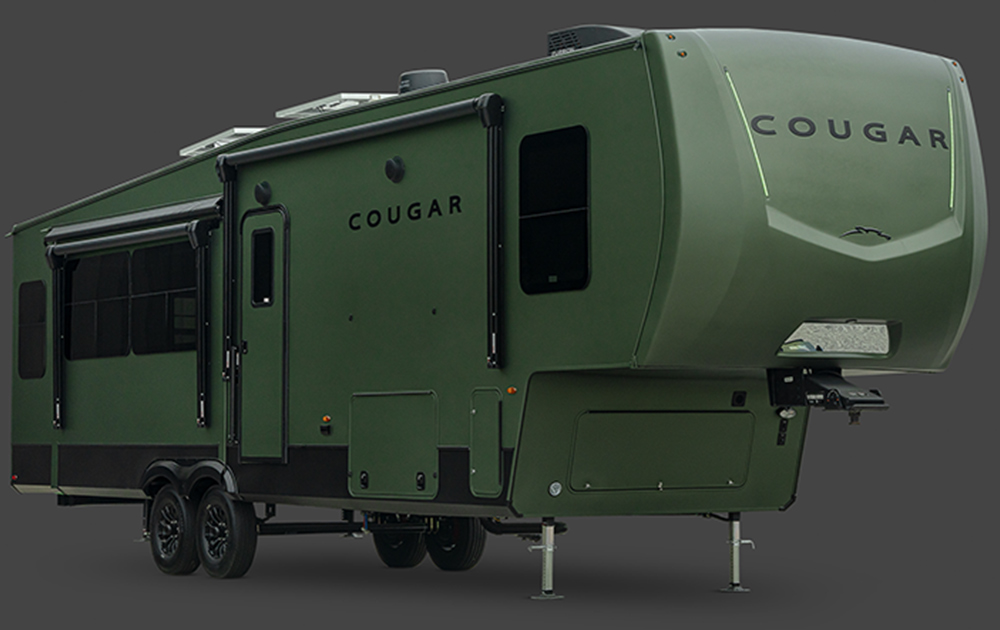
The Hero Edition’s striking matte green-colored full-body paint — which definitely has a military vibe to it — has been dubbed Heroic Green and was produced in the manufacturer’s in-house paint facility in Wakarusa, Indiana. The “Cougar” name and contemporary logo in raised lettering are the only exterior adornments which, paired with the matte green full-body paint, offers a subdued yet uniquely automotive-style design.
Keystone will donate $1,000 from every retail sale of the Cougar Hero Edition — which is available on four of the full-size Cougar’s seven floorplans — to the Wounded Warrior Project. Keystone’s total contribution will be no less than $250,000, and up to $1 million. According to Keystone General Manager Matt Christensen each donation is coming out of Keystone’s bottom line and is not just the company passing along the costs.
Each unit also will include a gift bag of Wounded Warrior Project items and other products to further commemorate the Hero Edition’s mission. For more information, visit keystonerv.com.
Sponsored Content
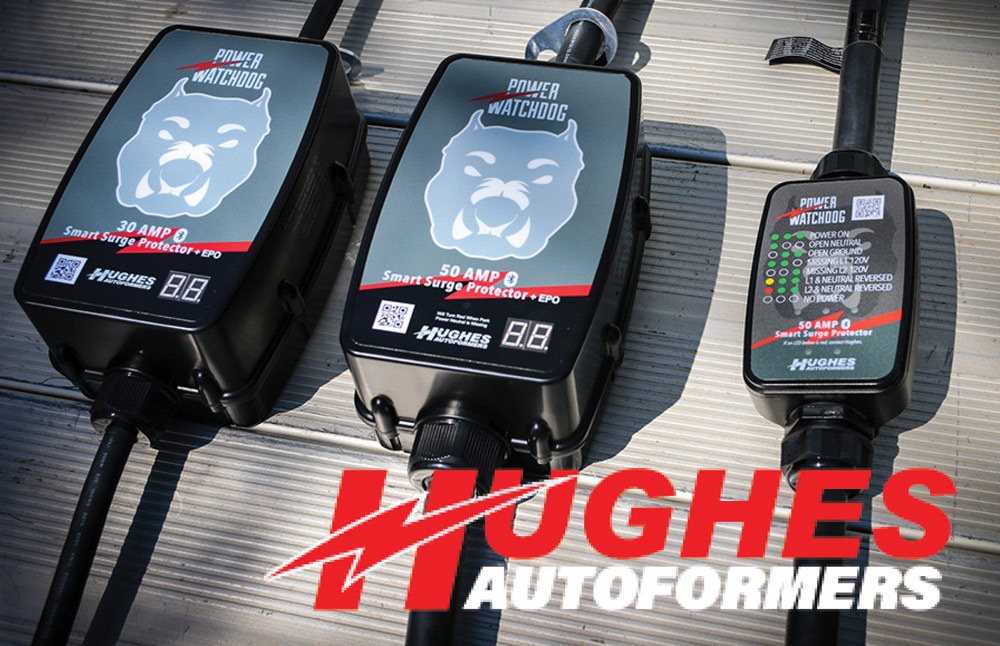
The Vital Need for Surge Protection in RVs
From smart TVs and satellite systems to refrigerators and HVAC units, your RV is loaded with high-tech gadgets that are vulnerable to the dangers of electrical surges. These surges can occur with little to no warning, often resulting from lightning strikes, faulty wiring or issues with a campground’s power supply. The consequences can be severe, possibly causing major damages that can cost thousands in repairs and replacements. Understanding the critical need for reliable surge protection, Hughes Autoformers designed the Power Watchdog, a surge protector that stands out in the RV accessory market for its innovative features and unmatched reliability.
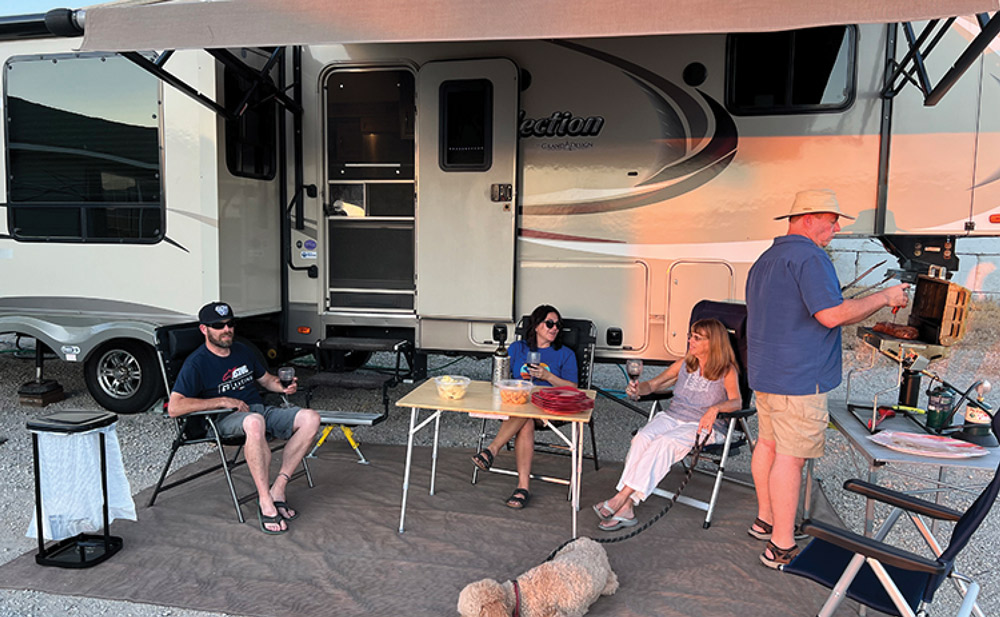
n previous articles, we explored how to choose an RV dealer based on their service operations and sales approach. While these are crucial aspects to choosing a dealer, there’s another important factor to consider: how engaged the dealership is in supporting their local community and the RV industry as a whole. A dealership that invests in its community and supports RV-related causes shows a commitment not just to making sales, but to fostering a healthy, vibrant RV lifestyle for everyone.
Engagement with the Local Community: Community engagement can take many forms, and sometimes it’s not directly related to RVs. For instance, many dealerships contribute to local high school sports teams or support charitable events. At Campers Inn RV, for example, we proudly support initiatives like the “Stuff the Bus” event in Jacksonville, Florida, “Toys for Tots” in several locations, “Seats for Soldiers” at local sporting events and “Bikes for Kids” in North Carolina. These contributions aren’t just about writing checks — they’re about being an active participant in making the community a better place.
When a dealership invests back into the community, it shows it isn’t just there to do business, but to be a good neighbor. When choosing a dealer, consider asking about its involvement in local causes — it’s a strong indicator of the dealership’s commitment to more than just profits.

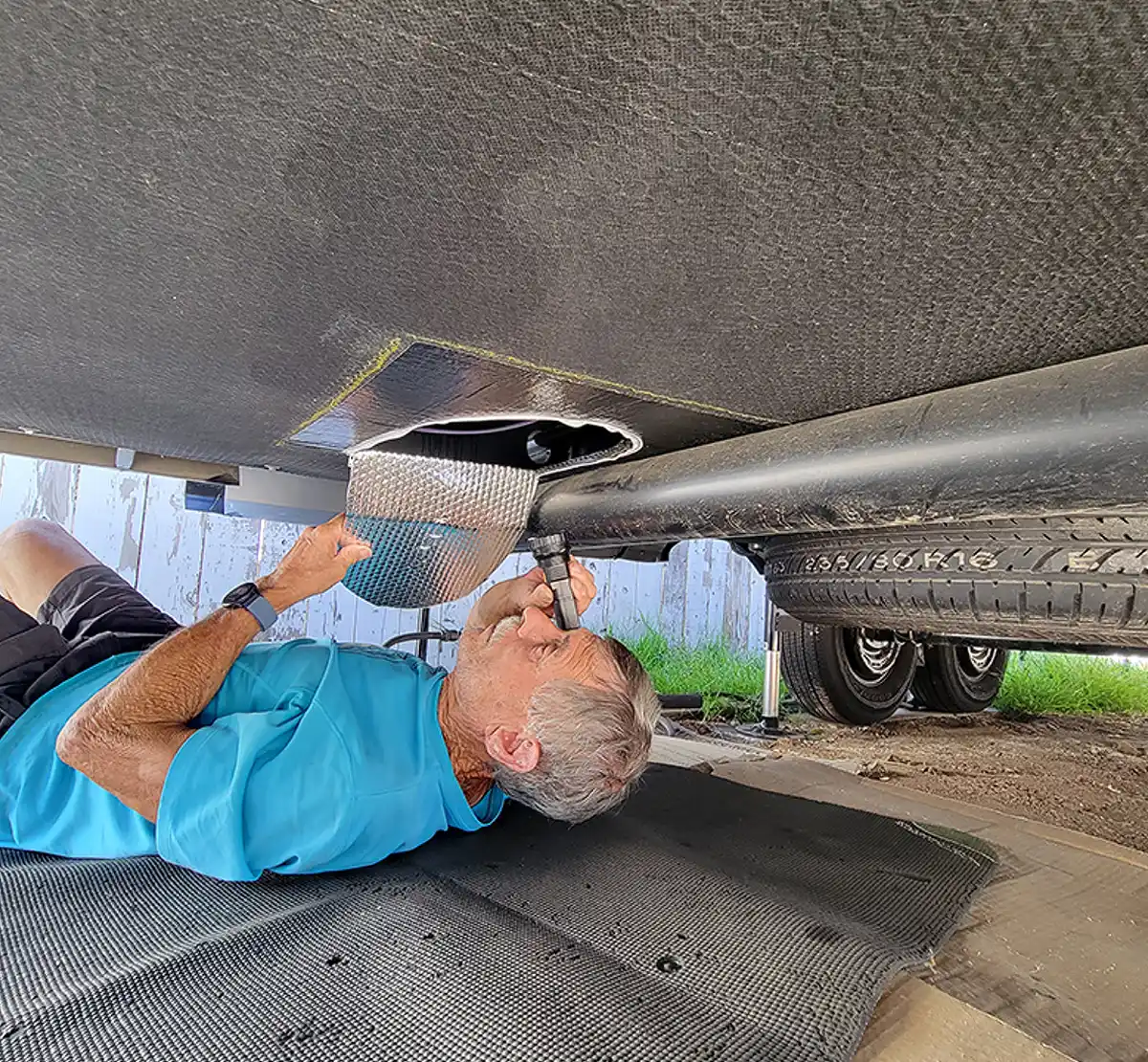
f you own a trailer or fifth wheel, at some point you are going to need to gain access to the area above the underbelly — especially if you have one or more slideouts. You might need to service the dump valves, chase down a water leak or repair shorted wires; in my case, I wanted to dry-lube the rack-and-pinion mechanism for the slides, which required that I have access to the motor and gearbox.
Granted, it’s always possible to cut an access hole in the underbelly material and patch it later with tape, but that rarely works for more than a short period of time.
The solution is to cut-in a trap door — and you can find the right product for this purpose on Amazon. Normally referred to as a “trap flap” in the belly pan used for manufactured homes, the “Mobile Home Belly Bottom Repair Trap Flap” ($12.99) is a woven polyethylene, zippered access panel designed to adhere to the Coroplast or other underbelly material used on modern trailers; it’s 18 x 18 inches square and has a rounded flap that unzips to provide access through the underbelly.


ost RV owners will tell you that Priority One is to always use caution when maneuvering their rigs over rough terrain or unknown places. The goal is to prevent impacts with tree limbs, rocks and other solid debris that goes unnoticed until too late. A vulnerable area is the belly pan, made of flexible material like Coroplast that can be easily cut or ripped from debris kicked up from the roadway or running over a tree stump, for example.
In my case, I cut a 5-inch-long section in the belly pan of my fifth wheel by mistake while working on a project. Yep — anybody can make a mistake.
Trying to fix that cut in the Coroplast with duct tape was futile, and sealing the cut with specialized tape for this purpose was also a no-go due to the rough surface, which was likely designed to help prevent accidental tearing. Nothing I’ve found thus far will stick solidly — for a reasonable length of time — to the underbelly material on my fifth wheel.
Sponsored Content
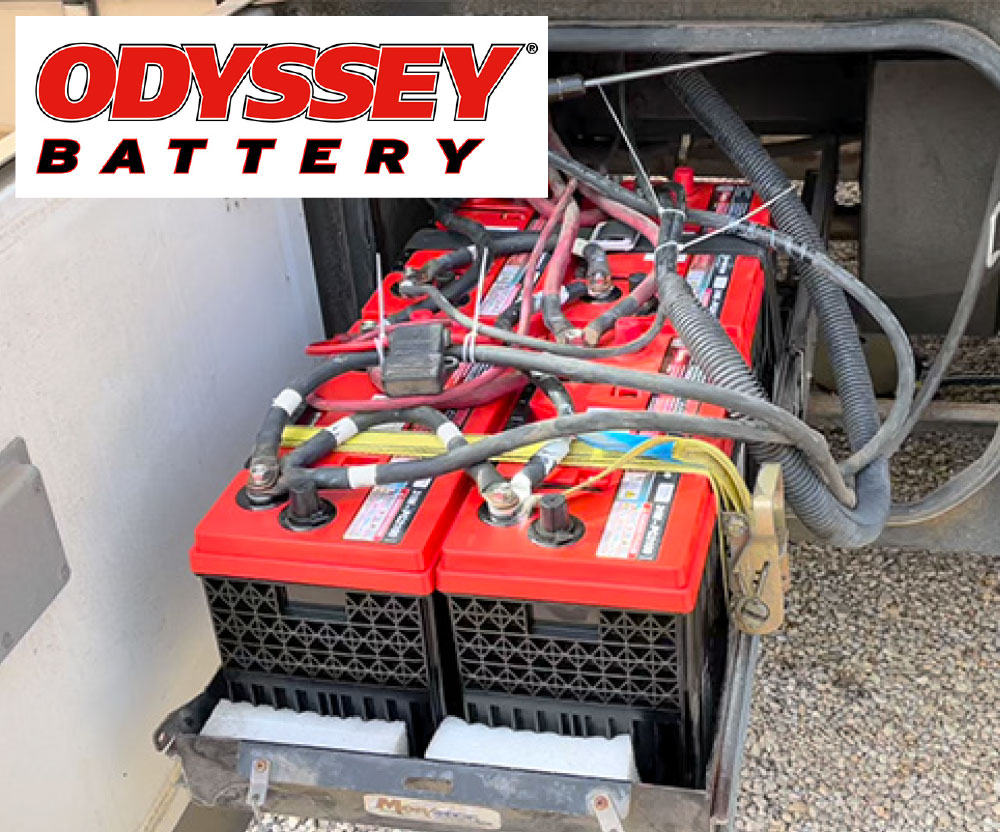
There are a variety of reasons why this could have happened — from improper storage or recharging to a build-up of corrosion on the battery terminals due to a lack of regular maintenance and upkeep. It’s important to recognize some of the most common reasons for your RV battery problems to help prevent premature power failure — and putting a glitch in your plans.
Improper Storage
If you plan to stow your RV during the winter months, it’s important to properly decommission your battery for storage to help prevent damage and keep it in good condition while sitting idle. This includes inspecting the battery for corrosion, worn cables and/or connectors, cleaning away any dirt or corrosion from the terminals, testing the battery’s State of Charge (SOC) and ensuring it has a full charge to help safeguard the performance and longevity of the battery.
Overheating
Depending on your geographical location in the world, the summer can bring temperatures of 100°F (37.8°C) or even higher. Hot weather can also drive up the temperature under the hood — so much so that it can lead to engine overheating and even accelerate the onset of battery failure.

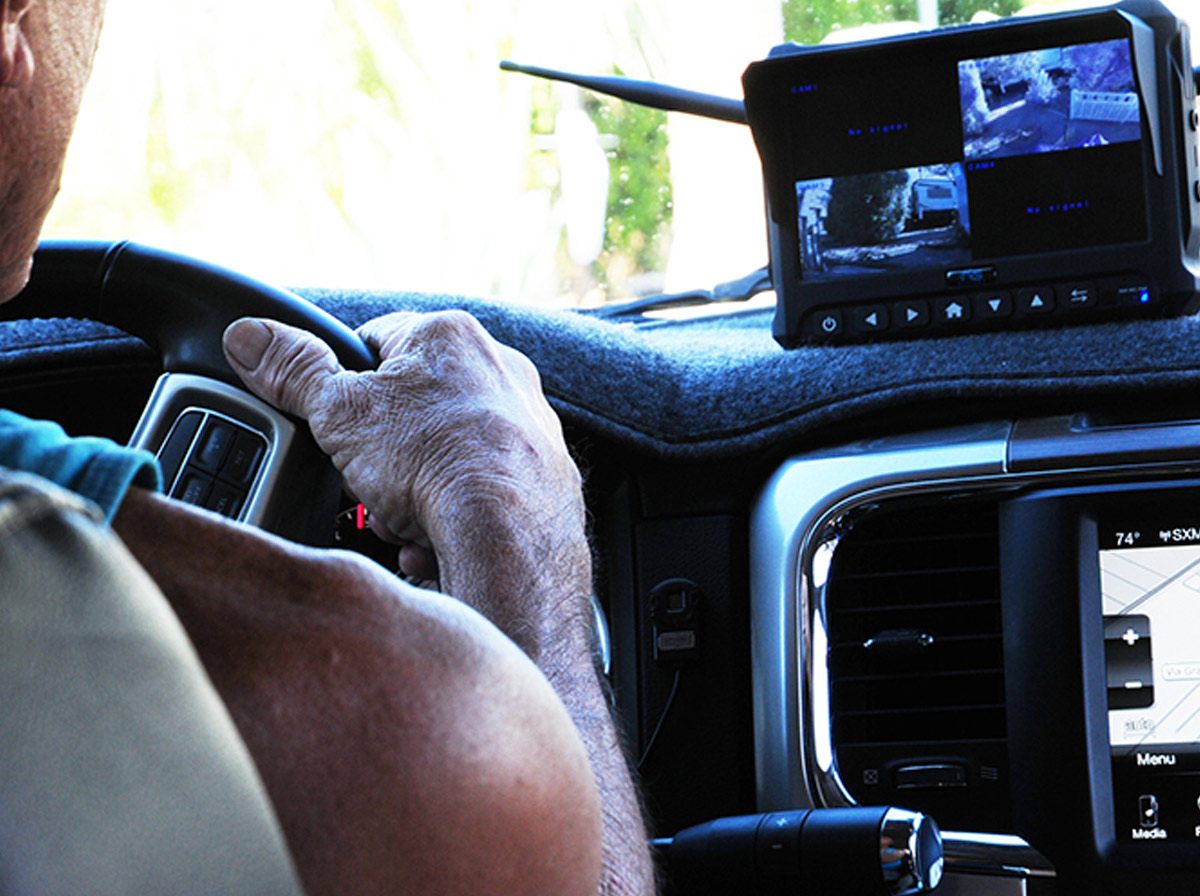
acking up an RV, whether it be motorized or towable, can send trepidations down one’s spine — especially those new to the lifestyle. Over time, most owners acclimate to the mechanical process — learning which way to turn the steering wheel and when — but not knowing what’s lurking behind you never goes away. There are classic remedies we wouldn’t suggest doing, like yelling at your other half because he/she misses obstructions or just can’t figure out how to direct the backing process, especially since a better way is to install a back-up camera and monitor the action yourself.
Simple backup systems for motorhomes have been around for a long time. In more recent years, manufacturers have recognized the necessity to eliminate blind spots and reduce back-in collisions with impossible-to-see obstructions and are offering pre-wiring and mounting bracket provisions or complete systems with a monitor as part of the supply starter box for even smaller towables. And for older RVs, the aftermarket is filled with choices.


ulling a trailer or fifth wheel presents inherent challenges that all owners deal with, from watching traffic on the roadways to maneuvering in an RV park. When on the road, drivers must be on the lookout for other vehicles that seem to come out of nowhere in adjacent lanes when passing. Then there’s backing up, especially on the blind side — and let’s not forget obstacles that are out of sight when parking in back-in RV sites, especially if there are a lot of trees or shrubs blocking the view. The ongoing joke about yelling at your co-pilot becomes all too real in difficult situations.
Backup cameras mitigate much of the stress, but what about the sides? Fortunately, backup camera systems can be upgraded with side view cameras — and even better, manufacturers are pre-wiring their trailers and fifth wheels for plug-and-play camera installations, as was the case on my fifth wheel purchased last year. Furrion, a Lippert division (lippert.com), markets camera kits designed specifically for this purpose (although several companies offering backup camera systems can provide adapters for trailers pre-fitted for Furrion components).

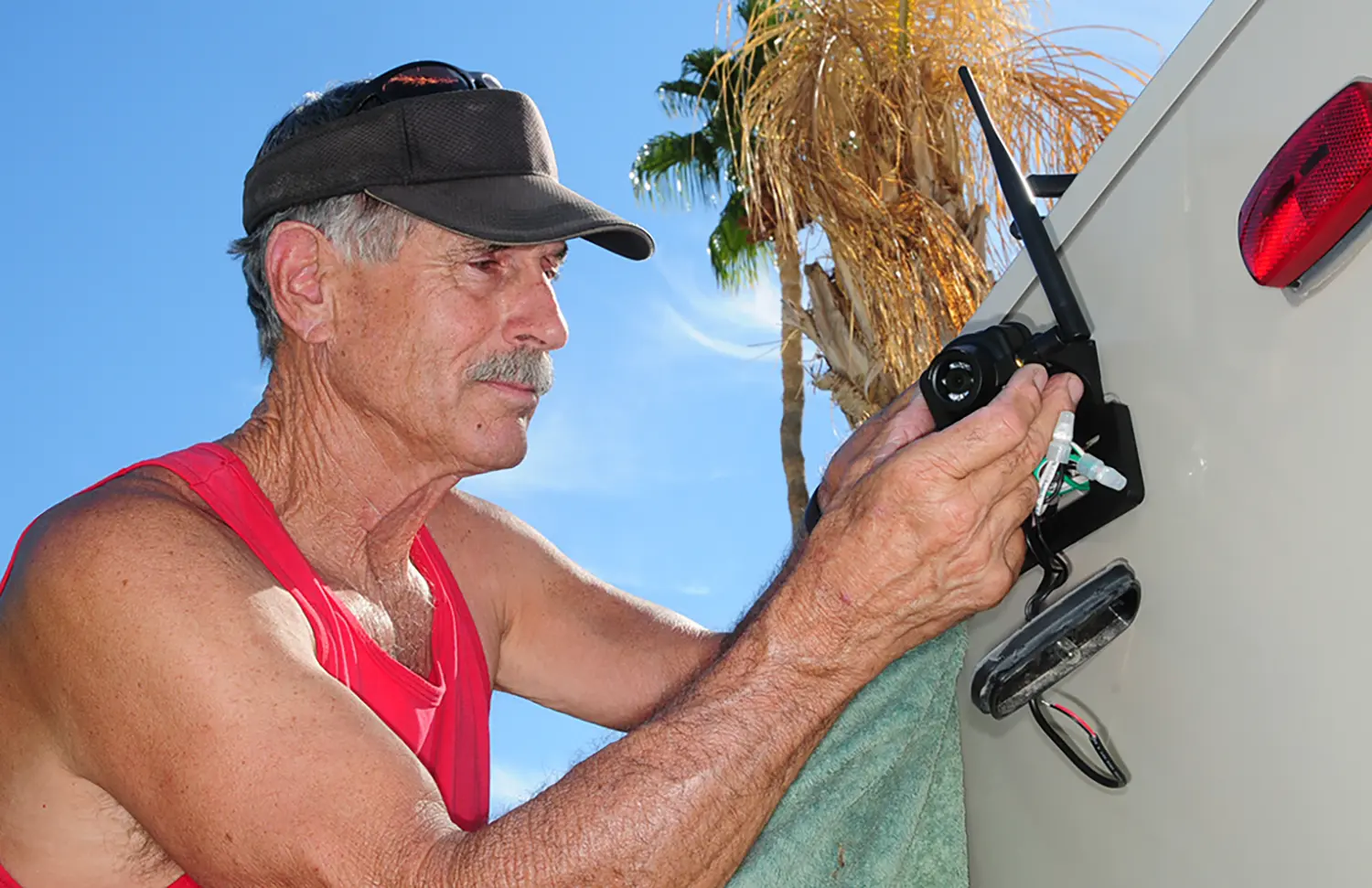
ackup cameras have proven to be a valuable tool to counter blind spots while driving or backing into an RV space. Just about all motorhomes have this provision, which is becoming more popular for trailer enthusiasts — with good reason. It can be argued that a view to the back and sides of a trailer or fifth wheel is even more important than for drivers of motorhomes. Recognizing the need to make towing a trailer as safe as possible, Hopkins Towing Solutions has devised an affordable product, the vueSMART backup camera (hopkinstowingsolutions.com), which can be installed in around 30 minutes to an hour.
The key to this system is a unique bracket that has been designed to supplant (temporarily) the center clearance light on the back of the trailer. A monitor for this system is not necessary; the images are transmitted via Wi-Fi to a smart device. There’s no provision for side-view cameras either, but this system was selling at etrailer for only $105 (etrailer.com), so you can’t expect the advanced features packed into the more elaborate systems.
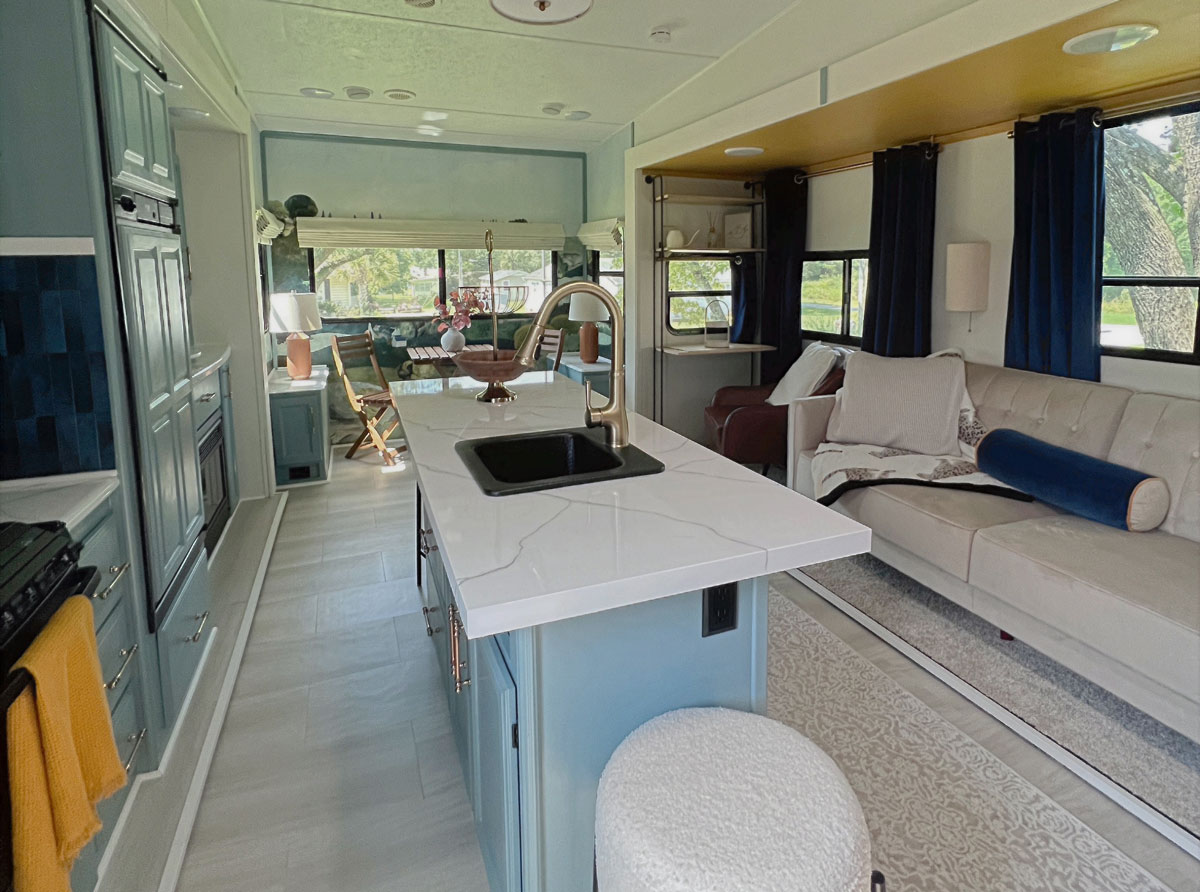


hile there’s no denying that RV manufacturers have made amazing strides in their quest to provide campers with a comfortable traveling home, each is still in the business to succeed — which means that every RV sitting on a dealer’s lot needs to appeal to as many potential buyers as possible. Mostly, that means what you’ll find are wood tones — and lots of them, at that. Aesthetically speaking, an RV designer’s palette made up of browns and tans and, more recently, whites, may not convey a specific owner’s personality, but neither are they especially off-putting.
Of course, that doesn’t mean you need to live with that color scheme forever. It simply means that you need to make some big changes yourself — or find someone to do it for you.
Someone like Tessa Terry. While relatively new to the growing cottage industry of RV renovators, the young mom from Andrews, South Carolina, has operated in a designer’s world for years. “My parents owned a Victorian lampshade company and I’ve worked around a lot of top designers my whole life,” she said. And while that niche provided her an outlet — in the Disney movie “Haunted Mansion,” she created all the lampshades used — it wasn’t until she and her husband, Aaron, began renovating their Victorian house while living in a tiny home that she began to understand the attraction of living in a small space. Since then, she’s customized nearly a dozen RVs as the proprietor of Alchemy RV Renovations (alchemyrvrenovations.com).

anitation systems in any RV are great to have — heck, they are a necessity — but keep in mind that you will likely be hauling around the “stinky stuff” that resides in the holding tanks. Handling the contents always brings sneers from outsiders, but taking care of the sanitation system is not really that bad.
Well, until the stink arrives.
Recently, at the end of one leg of a long trip in hot weather, I opened the entry door to my fifth wheel and was hit with very recognizable “stink” — and knew right away that the air admittance valve (AAV) in the bathroom and/or kitchen sink had seen better days.
Now, most people don’t know — or believe — that gray water can stink worse than black water for a number of reasons, including the fact the most people don’t flush these tanks while dumping; RVs are just not set up that way. Fortunately, the AAV is designed to control sewer gases that end up wofting hrough the P-trap — and it’s a very simply part to replace.

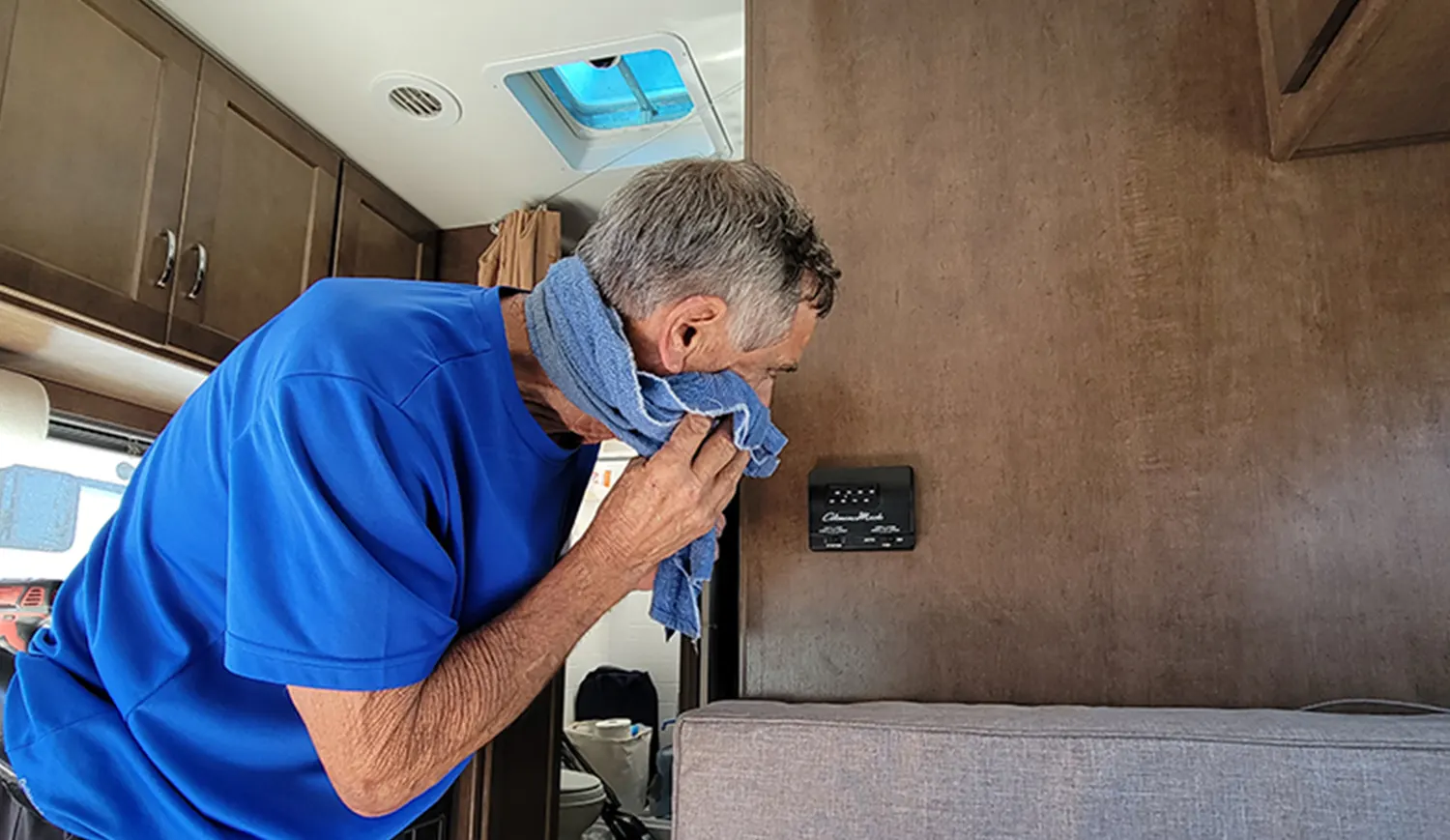
taying cool inside an RV is a prerequisite when traveling in hot weather, but it’s oftentimes easier said than done. While no one wants to endure a hot interior — especially when it comes to getting a good night’s sleep — an RV is essentially a big tube made of fiberglass, metal and glass, so it shouldn’t come as a surprise when temperatures inside that tube rise dramatically while it bakes under a hot summer sun.
And, while rooftop air-conditioners are commonplace on RVs today, their inherent design tends to limit effectiveness — especially on triple-digit afternoons. That’s why we’ve tested different add-on aftermarket products designed to maximize the efficiency of stock A/C units; we want to stay cool, too.
One of the newest products to address this situation is the A/C Connect from Kool RV (koolrv.com). The add-on product is claimed to elevate current air-conditioners to their full potential, bringing down the temperatures inside while curtailing some of the noise.


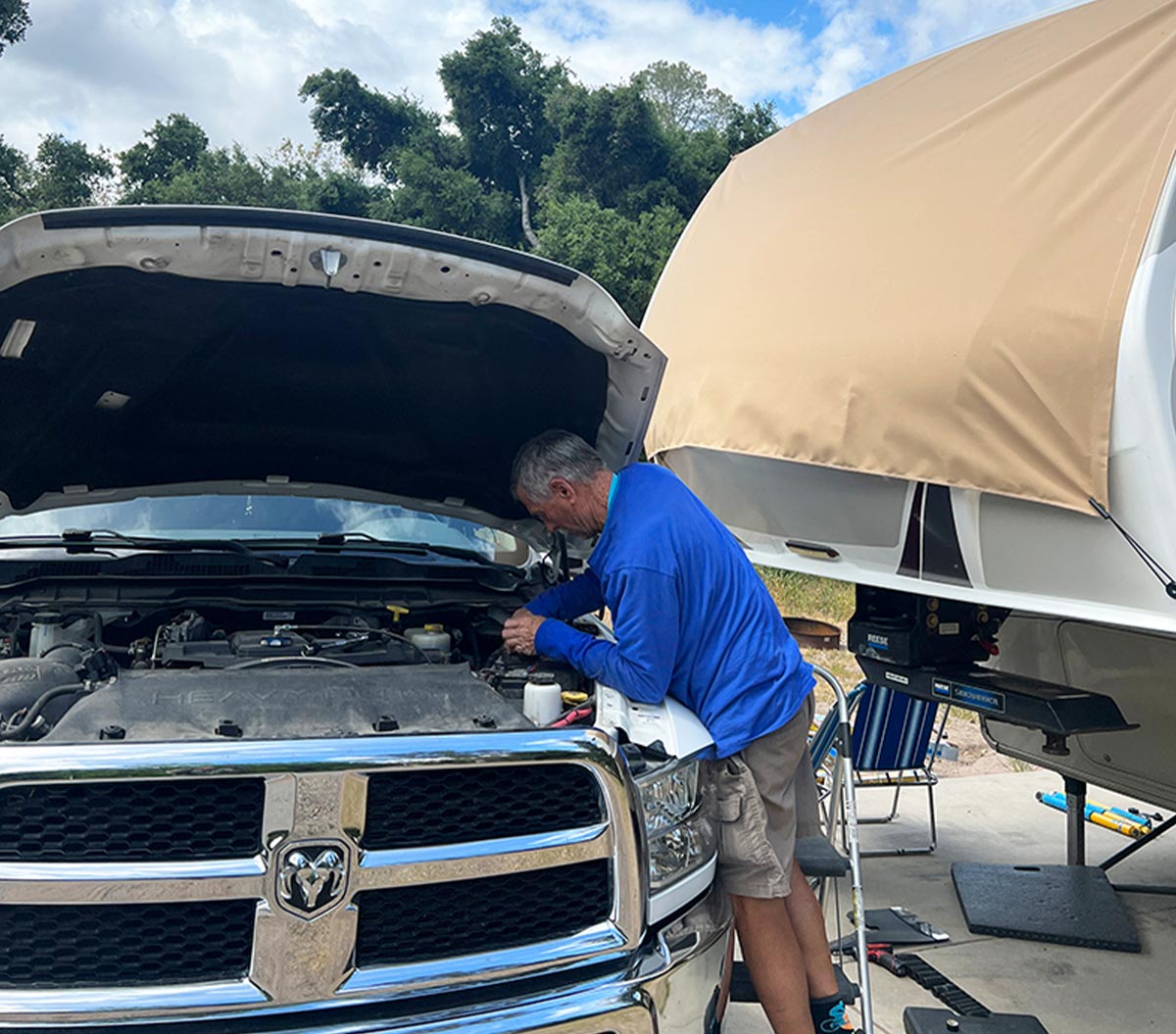
t’s no secret that factory shock absorbers provide only minimal damping of road conditions. Why? Because vehicle manufacturers typically use mass-produced equipment to fulfill this important suspension role — these cylindrical devices that bridge the gap between the frame and axle are designed to limit the stress on the suspension while controlling tire hop and adverse tire wear. Without shocks at every corner, the suspension would react wildly, producing a harsh ride, suspension bottoming and ultimately, an unsafe ride.
Most factory shocks have hydraulic-fluid valving, whereby piston-rod movement is restricted to provide a damping effect between the axle and frame. The movement turns kinetic energy into heat, which is dissipated to allow the shocks to do their job. However, most inexpensive shocks do not dissipate the heat efficiently — and, thus, the movement turns into mediocre suspension control. This configuration has been around virtually forever and, unfortunately, it doesn’t take long before mediocre support turns to virtually no support.



